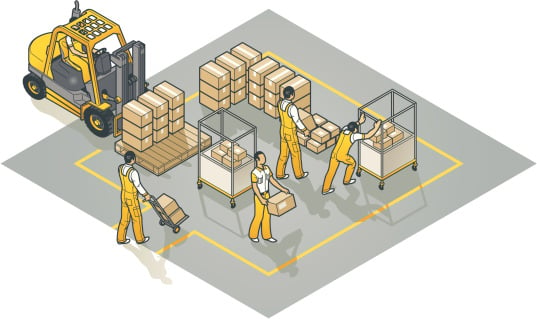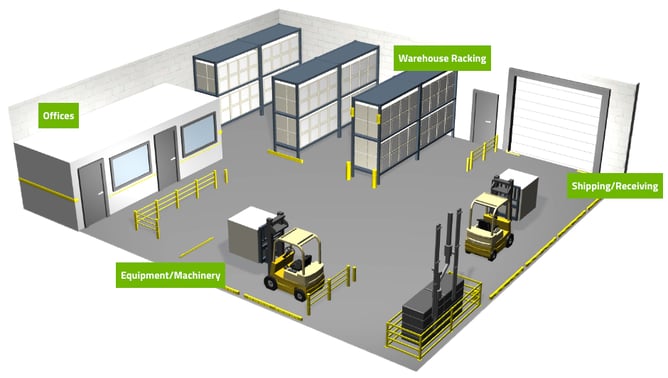REDWOOD LOGIN
Redwood PortalLTL
SCS
SCS Support
Rockfarm
Regardless of its size, a distribution center is a vital component within the supply chain. From juggling staffing issues, receiving and shipping out products, and inventory control issues, running a distribution center is incredibly complex. To maintain a finely-tuned operation, successful distribution managers follow a series of operational best practices. Noted below are nine distribution center best practices to implement.
 Every business understands the importance of maintaining a positive safety record. While reducing operational costs is an important way to maintain a solid profit margin, cutting expenses that can lead to on-the-job accidents is a recipe for disaster. For a distribution center, there are several hurdles that can cause accidents in the workplace – ranging from sharp objects, moving equipment, and/or constant bending and lifting. By staying on top of safety training, upgrading and maintaining equipment, and reducing the potential for accidents in the facility – you’ll save more money on reduced worker’s compensation claims than could possibly be gained through cut-backs.
Every business understands the importance of maintaining a positive safety record. While reducing operational costs is an important way to maintain a solid profit margin, cutting expenses that can lead to on-the-job accidents is a recipe for disaster. For a distribution center, there are several hurdles that can cause accidents in the workplace – ranging from sharp objects, moving equipment, and/or constant bending and lifting. By staying on top of safety training, upgrading and maintaining equipment, and reducing the potential for accidents in the facility – you’ll save more money on reduced worker’s compensation claims than could possibly be gained through cut-backs.
Preventing theft is another item that should be on any distribution center’s best practices list. While pre-employment background checks have improved in recent years, theft from a distribution center is quite alluring to some employees. When it comes to employee theft, it’s vital to activate a “trust but verify” approach with all employees – from order pickers to management.
Budgeting monthly and quarterly expenses is a challenge for many older distribution centers with equipment that might be wearing thin. For operational efficiency, it’s critical to keep your equipment running smooth, however, there is a great way to reduce the potential of equipment breakdown. Smart distribution centers stay on top of routine maintenance by setting aside money and resources each month for equipment maintenance.
When you need to replace skids, pallet jacks, forklifts, and storage steel, how do you go about accomplishing this task? If you ask large-scale distribution center managers, they’ll likely tell you that they have outstanding and honest relationships with their equipment vendors. As technology improves the equipment you need to maintain distribution center efficiency gets better. When you maintain a solid relationship with your vendors, they keep you aware of new equipment that is stronger, better, and safer to use.
While technology helps a distribution center operate efficiently, it can be expensive to integrate into your daily operations. Most smart managers understand the importance of upgrading technology slowly. There are many benefits to this type of activation.
 Whether it’s a CRM system, or inventory control, removing the human element from data collection reduces mistakes. One way that distribution centers improve customer relationships, maintain positive inventory, and keep the busy center running like a Swiss watch is through automation. As noted above, automated systems can be expensive, so be sure to make your automation activation scalable in proportion to your budget.
Whether it’s a CRM system, or inventory control, removing the human element from data collection reduces mistakes. One way that distribution centers improve customer relationships, maintain positive inventory, and keep the busy center running like a Swiss watch is through automation. As noted above, automated systems can be expensive, so be sure to make your automation activation scalable in proportion to your budget.
It’s common for any company who maintains an inventory of supplies or merchandise to complete frequent inventory counts. However, technology improvements such as hand-held scanners, barcodes, and picking procedures have created ongoing cycle counts. This can reduce the need for tedious physical inventory counts that often produce mistakes and ongoing payroll issues.
Every time an item is touched, the potential for damage, mistakes in packaging, and theft increases. Due to this fact, distribution centers and warehouses have begun to streamline the process of handling merchandise. Whether it’s through the picking and packing process, or shipment and fulfillment, when you reduce the number of times an item is touched by a person, you’ll improve distribution operational efficiency.
If you ask the most successful managers and CEO’s about how they operate their business, forward thinking and planning is a common reply. It might be tempting to ease off the gas pedal of operation or set the business on cruise control when things are going well – but this often leads to mistakes. A distribution center should always stay on top of daily operations, payroll, maintenance, and safety to reduce the potential of accidents, mistakes, and those unexpected expenses.